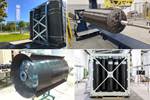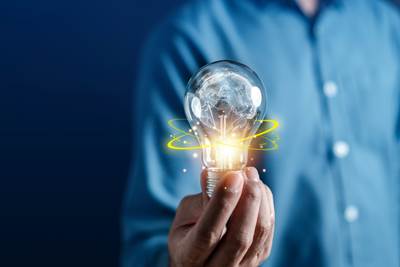Graphmatech launches Aros polyamide-graphene for Type 4 tanks, secures grant
Combination of polyamide grades and graphene introduces low-permeation solution for upscaling H2 storage, transport applications.
Graphmatech (Uppsala, Sweden) announces the launch of a range of polymer-graphene composites, Aros polyamide-graphene, suitable for Type 4 composite pressure vessels. The company has also secured a 10 million SEK grant (approximately $938,000) from the Swedish Energy Agency to support this development, which aims to significantly reduce harmful hydrogen (H2) leakage into the atmosphere.
Graphmatech’s range of polymer-graphene composites combines polyamide grades with graphene, which is reported to effectively block H2 from escaping while also making the polymer stronger. The custom-designed production process for combining polyamide and graphene is also said to solve a major problem for scientists: How to prevent graphene particles from clumping together (agglomeration) during upscaling. This clumping issue has previously limited graphene’s use in industrial applications.
These performance gains are said to enhance polyamide’s competitiveness against use of metal in H2 storage, improving safety and design flexibility while enabling thinner, more efficient storage construction. Aros polyamide-graphene can also be used as a replacement for existing solutions, enabling lower H2 permeation, increasing safety margins and decreasing the CO₂ footprint of the final pressure vessel design.
The Aros polyamide-graphene composites include ready-to-use compounds and concentrated masterbatches (additive blends). The range of Aros polyamide-graphene composites include Aros polyamide-6 (PA6) graphene and Aros polyamide-11 (PA11) graphene composites, which feature the following properties:
Aros PA6:
- Reduced H2 leakage by up to 83% compared to traditional commercial solutions
- Increased tensile modulus (strength) by up to 98% and ultimate strength by 38% compared to commercial solutions
- Blow-moldability and good parison strength, meaning it can be shaped into hollow forms using industrial blowing techniques, while maintaining structural integrity during the manufacturing process.
Aros PA11:
- Decreased hydrogen permeability of PA11 commercial benchmark by 68%
- 160% increased elongation capability before breakage occurs
- 12% boost in the material’s ability to handle impact at room temperature.
According to the company, H2 is approximately 11 times more harmful to the environment than CO2 over a 100-year period, and so any leaks from H2 storage and transportation can significantly contribute to climate change. Moreover, H2 leakage poses substantial financial risks and safety hazards, particularly in enclosed spaces where the gas can accumulate and create explosion risks.
Graphmatech’s focus on graphene applications, rather than raw material production, positions it strategically within the supply chain to drive widespread adoption of its technology. By 2027, Graphmatech’s solution is expected to be implemented in approximately 1,000 light commercial vehicles and 500 heavy commercial vehicles. By 2032, there is an anticipated implementation in 750,000 light commercial and 250,000 heavy commercial vehicles. This adoption could potentially lead to a substantial reduction in CO² emissions, estimated at 50,500 tons per year by 2027 and 450,000 tons per year by 2032.
The launch of Aros polyamide-graphene coincides with Graphmatech securing a grant from the Swedish Energy Agency. The grant supports the development and deployment of a modular mobile pilot-scale extrusion line for Graphmatech’s polymer-graphene materials tailored for H2 applications. Additionally, it enables the company to develop, test, demonstrate and certify Type 4 pressure vessels for H2 storage and pipes for H2 transportation. This project aims to verify the modular extrusion line at a pilot scale under full operating conditions, demonstrate the functionality of bio-based polymer polyamide-11-graphene composites in Type 4 tanks and investigate the recyclability of polymer-graphene composite-based Type 4 tanks.
“By infusing traditional materials with the ‘miracle’ properties of graphene, we’re enabling a new era of safer, more efficient H2 infrastructure that can significantly reduce CO² emissions on a global scale,” says Dr. Mamoun Taher, founder and CTO of Graphmatech, “As a deep-tech for climate startup, we’ve not only solved the challenge of graphene commercialization, but also removed risk in its industrial adoption. With the Aros Polyamide-Graphene composites and the support of the Swedish Energy Agency, we’re providing multiple sectors with the tools to future-proof their operations, enhance productivity and strive for true sustainability.”
Related Content
Novel composite technology replaces welded joints in tubular structures
The Tree Composites TC-joint replaces traditional welding in jacket foundations for offshore wind turbine generator applications, advancing the world’s quest for fast, sustainable energy deployment.
Read MoreRecycling end-of-life composite parts: New methods, markets
From infrastructure solutions to consumer products, Polish recycler Anmet and Netherlands-based researchers are developing new methods for repurposing wind turbine blades and other composite parts.
Read MoreUpdate: THOR project for industrialized, recyclable thermoplastic composite tanks for hydrogen storage
A look into the tape/liner materials, LATW/recycling processes, design software and new equipment toward commercialization of Type 4.5 tanks.
Read MoreDrag-based wind turbine design for higher energy capture
Claiming significantly higher power generation capacity than traditional blades, Xenecore aims to scale up its current monocoque, fan-shaped wind blades, made via compression molded carbon fiber/epoxy with I-beam ribs and microsphere structural foam.
Read MoreRead Next
Composites end markets: Pressure vessels (2024)
The market for pressure vessels used to store zero-emission fuels is rapidly growing, with ongoing developments and commercialization of Type 3, 4 and 5 tanks.
Read MoreMikrosam equips BTU Germany with single-tape AFP head for Type 5 pressure vessels
Delivery of upgraded placement head provides additional automated layup flexibility, quality control for the university’s latest projects advancing Type 4 and 5 hydrogen storage.
Read MoreGraphene Composites announces approval of Heat Management Systems patent
Thermal management patent describes an engineered, potentially self-powered nanomaterial design that could efficiently transfer thermal energy to better protect vehicle applications.
Read More

























